Raised garden beds are perfect for growing ornamental plants, flowers, and vegetables. While planning to grow plants over raised beds, a question will arise: How much soil do I need for a raised bed? That is what I will share today in this article.
The portion of soil needed for the raised beds depends on the bed size. Multiply your bed’s length, width, and height to find the approximate soil volume. To reduce soil consumption, you can also fill the bottom of the raised bed with fillers like logs, sticks, and other organic matter.
There are certain formulas to calculate, and they differ depending on the shape of your raised bed.
This article will explore the different formulas for calculating the amount of soil required and soil quantities required by some common raised bed sizes.
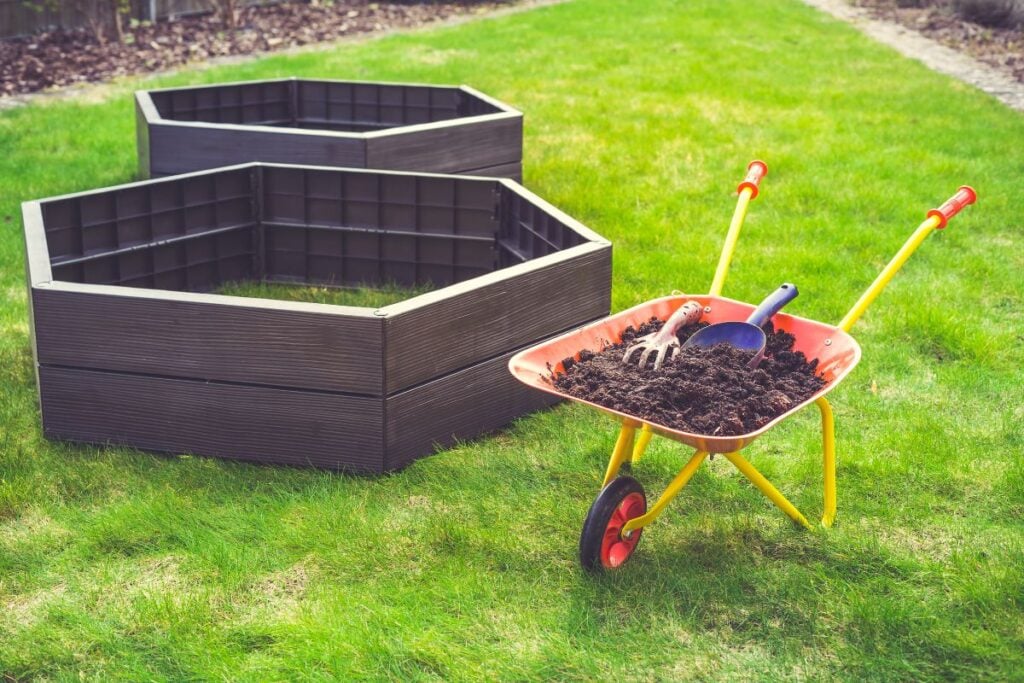
How much soil do raised beds need?
The amount of soil needed by your raised beds depends on the size and depth of your bed.
Different beds have different sizes, so the amount of soil required will differ.
There is no fixed amount to it.
If you are unsure about the height or depth of your bed, plan and research the plants you want to grow and understand how deep their roots can grow.
Based on the root depth, measure the bed depth and make it according to your plants’ needs.
Once you make the bed, it is time to assume the amount of soil required.
There are some formulas to understand the amount of soil needed.
You can also use soil calculator tools to determine the quantity of soil.
Formulas for calculating the amount of soil required by raised beds
To calculate the amount of soil to be filled in your raised bed, you must multiply the length, width, and height of the raised bed.
It will let you know the quantity of soil in cubic feet needed to fill the bed.
The formulas will differ depending on the raised bed type.
Make sure to convert the measurements into feet and not inches to know the amount of soil in cubic feet.
Also read: How Deep Should A Raised Garden Bed Be? (With 40 Vegetable Examples)
The formula for rectangular or square raised bed
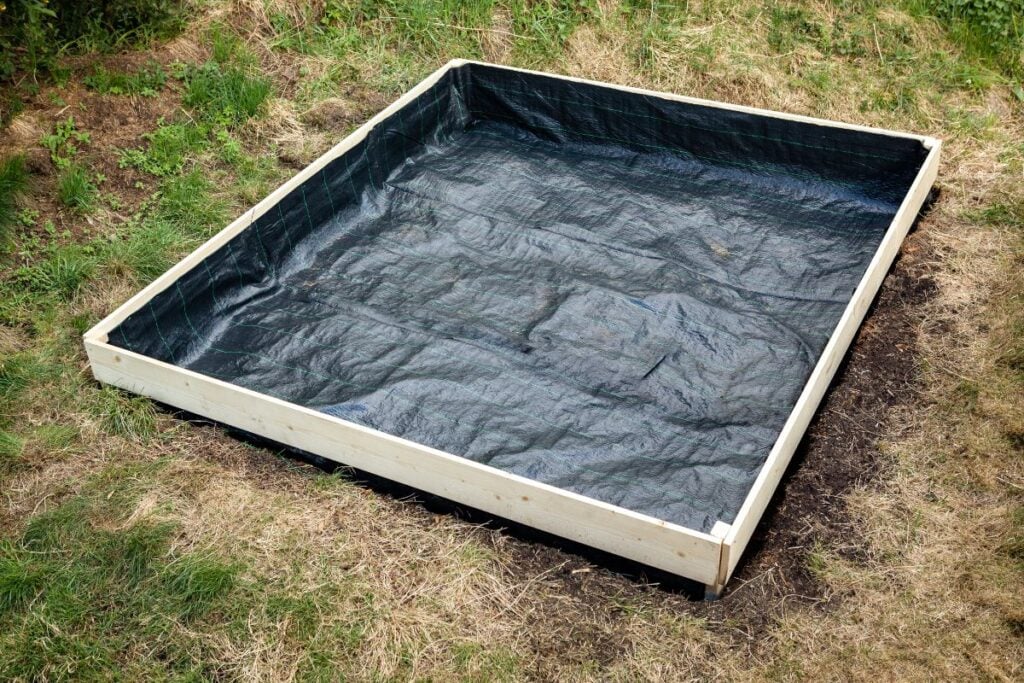
Here is the formula:
V = WxLxH
- V means soil volume
- W is the bed’s width
- L is bed’s length
- H is the bed’s height
Let me share an example.
Begin with measuring the length, width, and height of your bed.
You don’t have to think about the inside or outside. Measure in the same unit, i.e., feet.
If your bed is 6 feet long, 3 feet wide, and 16 inches high, change the inch into feet.
Calculate it as 6x3x1.3 feet.
After multiplying them, the result is 23.4 cubic feet.
So, you will need this much cubic of soil for your raised beds.
You can divide it by 27 if you want to know the amount of soil in cubic yards because many stores sell the bulk of soil in cubic yards.
The formula needed for circular raised beds
In circular raised beds, you won’t find the length or width.
So, it would be best to find the measurement of the radius and the height or depth.
The radius of the bed is half the diameter of the circular bed.
Then square the radius and multiply it by 3.12.
Then multiply the result by the height to get the volume of soil needed.
The formula is V = r^2×3.14xH
The formula needed for geometric beds
The formula for a hexagonal raised bed is V = 3/2(√3) S2xH
- Here, S means the length of one side of a regular hexagon bed.
- V is the soil volume.
- H is the height or depth of the bed.
Looking for gardening supplies? We have tested 100's of products before recommending them to you guys. Check out our best pick below:
| Image | Gardening Supplies | Best Price? |
|---|---|---|
 Top
Top Top
Top | Raised Garden Bed Kit | Check On Amazon |
 | XLUX Soil Moisture Meter, Plant Water Monitor, Soil Hygrometer Sensor for Gardening, Farming, Indoor and Outdoor Plants, No Batteries Required | No Results |
 Top
Top Top
Top | 82 Pcs Garden Tools Set and Extra Succulent Tools Set | Check On Amazon |
 | Joeys Garden Expandable Garden Hose with 8 Function Hose Nozzle, Lightweight Anti-Kink Flexible Garden Hoses, Extra Strength Fabric with Double Latex Core, (50 FT, Black) | No Results |
 Top
Top Top
Top | Dual Chamber Compost Tumbler | Check On Amazon |
 Top
Top Top
Top | Sunnyglade Plant Stakes | Check On Amazon |
 Top
Top Top
Top | Organic Cold Pressed Neem Seed Oil | Check On Amazon |
 Top
Top Top
Top | Mighty Mint Gallon :-Insect and Pest Control Peppermint Oil | Check On Amazon |
 Top
Top Top
Top | Scotts DiseaseEx Lawn Fungicide | Check On Amazon |
 Top
Top Top
Top | Jacks Classic 20-20-20 All Purpose Fertilizer | Check On Amazon |
 Top
Top Top
Top | 30,000 Seeds Pollinator Attracting Wildflower Mixture | Check On Amazon |
 Top
Top Top
Top | Survival Vegetable Seeds Garden Kit-Over 16,000 Seeds | Check On Amazon |
The formula for octagonal raised beds
The shape resembles an octagonal prism.
Octagonal beds can come both in regular octagons where all sides have the same measurements and irregular octagons where the sides have different measurements.
The formula for this kind of bed is:
V = 2(1+√2) S2xH
S is the length of one side of the regular octagons.
Calculating the soil quantity of L-shaped raised beds
To calculate the soil quantity of L-shaped beds, you need to divide your bed into two figures, for example, a square and a rectangle.
Then, measure the length, width, and height of the figures.
Now, use the rectangle formula and add the measurements of the two figures.
So, the formula stands somewhat like this:
V = (WxLxH) + (WxLxH)
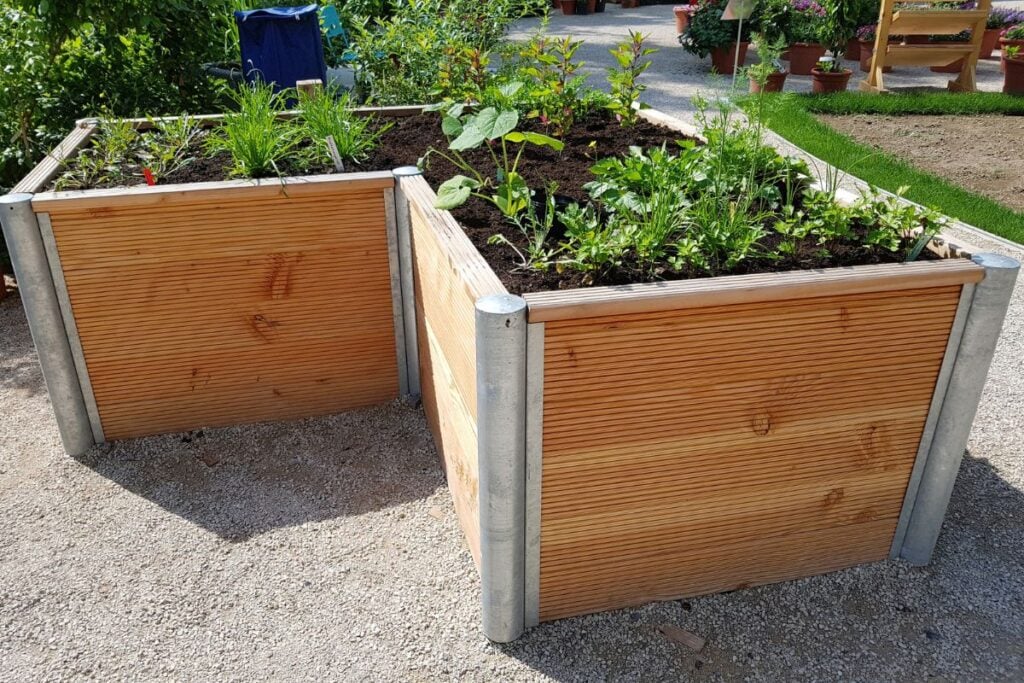
How to calculate the soil of U-shaped raised beds?
Here, you have to divide your beds into three figures, for example, one rectangle and two squares.
First, find out the length, width, and height of the individual figures and multiply each of them.
After that, multiply and add the results of the three figures.
The formula should be:
V = (WxLxH) + (WxLxH) + (WxLxH)
How much soil will irregular raised bed shapes need?
Sometimes, we create irregular bed shapes.
Since there is no formula for irregular bed shapes, you can treat them as a rectangle shape if the bed is very long.
Then, measure from the longest point and apply the formula for rectangular beds.
For an exact amount, calculate the base area of the bed and then multiply it with the height of the bed.
If you have a long hexagon or octagon, divide the bed base into three triangles and rectangles and then find out the area for each of the figures and add them.
After finding out the base area, multiply the result by the height of the bed.
The outcome that comes at the last calculation is the amount of soil your bed will need.
How much soil will odd bed shapes need?
Most raised beds have proper shapes and sizes where the inside and outside don’t matter.
But, for some odd-shaped beds, the inside and outside are very different.
So, the amount of soil required here differs from the above beds.
To find out the exact amount of soil for such beds, take the measurements from the inside to avoid wasting extra soil.
For example, farmstead beds are made with a Mortis and tenon construction.
So, the end of these beds will be larger than the dimensions inside the bed.
Some common bed sizes and their soil requirement
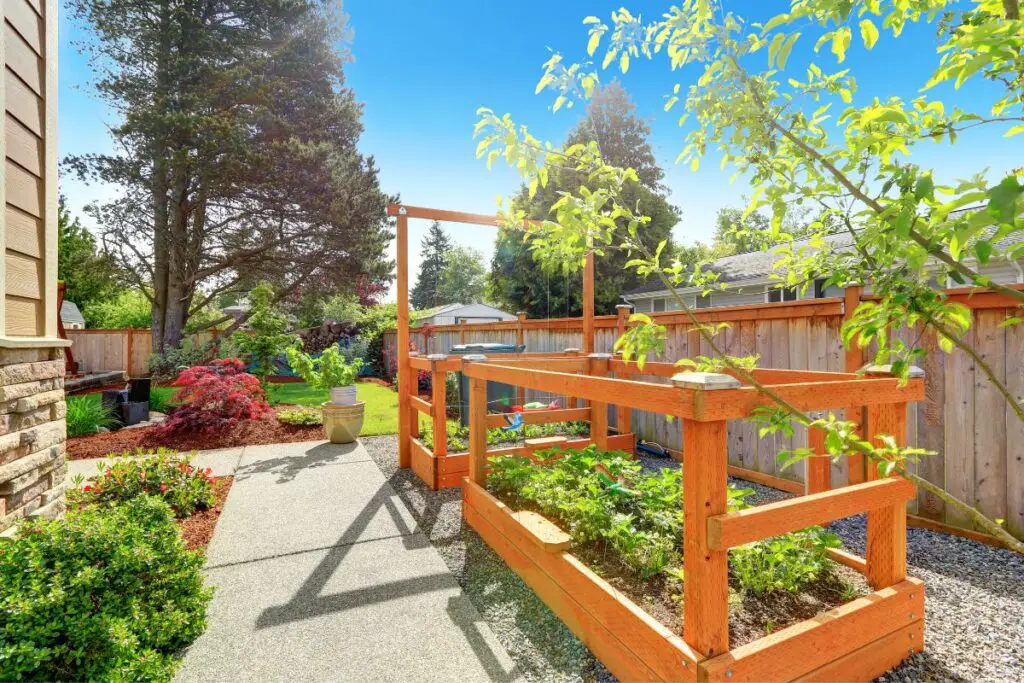
The standard size for raised beds would be at least 3-4 feet wide, 6-8 feet long, and 11 inches deep.
It is the minimum measurement for most plants, including vegetables like cucumbers and tomatoes.
Most builders sell ready-made beds, and most have this standard size.
However, when you build one in your home, you can make any size of your choice.
The soil bags can differ because there are bags with multiple measurements:
- 0.75 cubic feet of soil per bag
- 1.5 cubic feet of soil per bag
- 2 cubic feet of soil per bag
- 3 cubic feet of soil per bag
I will share all the measurements and the bags required according to them.
Here is a table of some common raised bed sizes, the soil amount, and the number of soil bags required with different cubic feet per bag:
| Bed size in foot | Cubic feet of soil needed | 0.75 cu. ft. per bag | 1.5 cu. ft. per bag | 2 cu. ft. per bag | 3 cu. ft. per bag |
|---|---|---|---|---|---|
| 2x2x0.5 | 2 cubic feet | 3 bags | 2 bags | 1 bag | 1 bag |
| 2x2x1 | 4 cubic feet | 6 bags | 3 bags | 2 bags | 2 bags |
| 2x2x1.6 | 7 cubic feet | 9 bags | 5 bags | 4 bags | 3 bags |
| 2.5x7x2 | 35 cubic feet | 47 bags | 24 bags | 18 bags | 12 bags |
| 4x4x0.5 | 8 cubic feet | 11 bags | 6 bags | 4 bags | 3 bags |
| 4x4x0.66 | 11 cubic feet | 15 bags | 8 bags | 6 bags | 4 bags |
| 4x4x1 or 4x8x0.5 | 16 cubic feet | 22 bags | 11 bags | 8 bags | 6 bags |
| 4x4x2 or 4x8x1 | 32 cubic feet | 43 bags | 22 bags | 16 bags | 11 bags |
| 4x4x1.6 | 27 cubic feet | 36 bags | 18 bags | 13 bags | 9 bags |
| 4x8x0.66 | 21.44 cubic feet | 29 bags | 15 bags | 11 bags | 8 bags |
| 4x8x0.92 (average for most plants) | 29 cubic feet | 40 bags | 20 bags | 15 bags | 10 bags |
| 4x8x1.6 | 53 cubic feet | 70 bags | 35 bags | 26 bags | 18 bags |
| 4x8x2 | 64 cubic feet | 86 bags | 43 bags | 32 bags | 22 bags |
| 4x10x1 | 40 cubic feet | 54 bags | 27 bags | 20 bags | 14 bags |
| 8x8x0.5 | 32 cubic feet | 43 bags | 22 bags | 16 bags | 11 bags |
| 8x8x1 | 64 cubic feet | 86 bags | 43 bags | 32 bags | 22 bags |
| 8x8x1.6 | 107 cubic feet | 142 bags | 71 bags | 54 bags | 36 bags |
In some stores, bulk soil is sold in cubic yards. One cubic yard is equal to 27 cubic feet.
In that case, divide the multiplied result by 27 and convert it into a cubic yard.
If your raised bed measurements don’t match the above table list, you have to calculate and find out the number of cubic feet of soil required.
Transfer the result into a cubic yard if required.
Then find out the number of bags needed for your raised beds.
Soil depths for raised beds for some plants
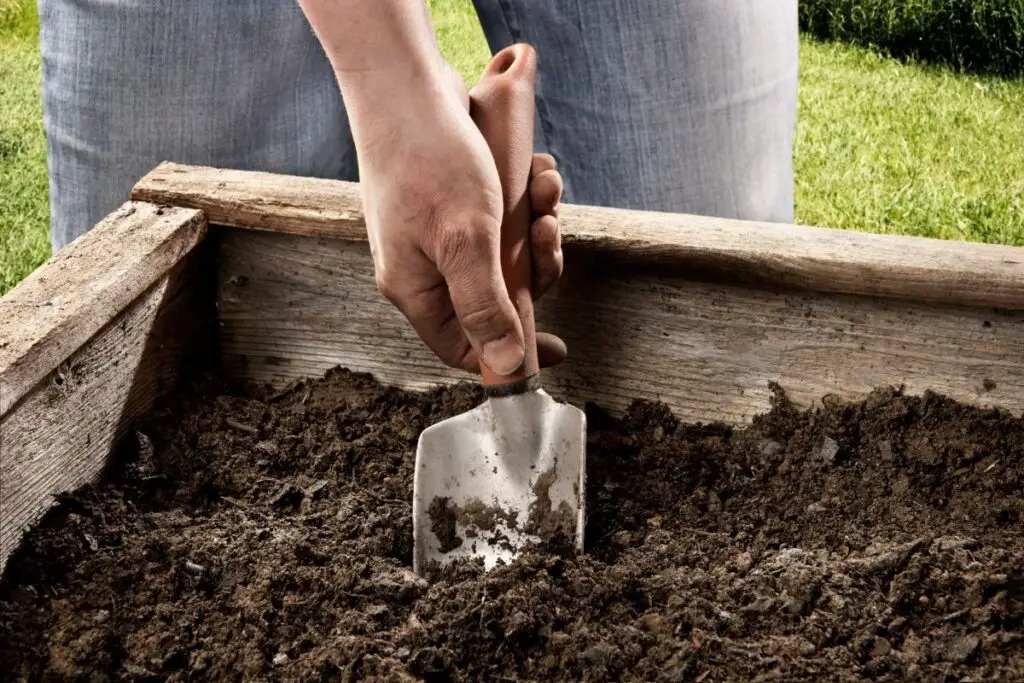
There is no fixed measurement for raised beds.
Depending on the plants’ requirements, you must make the right one for them.
Though you can keep the length and width the same, the height of the bed will differ depending on the plant you are growing because different plants have different root depths.
Some plants have shallow roots, some have average-length roots, and some plants are deep-rooted.
Here is a list of some plants and the raised bed heights:
6-inch raised bed:
- Arugula
- Lettuce
- Spinach
- Onions
- Leeks
- Radishes
- Basil
- Chives
- Strawberries
- Dill
- Cilantro
- Mind
- Marigold
- Theme
- Oregano
- Parsley
- Annual flowers
12-inch high raised bed:
- Garlic
- Kale
- Summer squashes
- Broccoli
- Brussels
- Beans
- Beetroot
- Sprouts
- Cabbages
- Cantaloupes
- Cucumbers
- Cauliflowers
- Collards
- Turnips
- Rosemary
- Sage
- Calendula
- Lantana
- Borage
- Nasturtiums
- Alyssum
- Snapdragons
- Swiss chard
- Lavender
- All in the 6-inch list
20-inch high raised bed:
- Eggplant
- Tomatoes
- Artichokes
- Sweet potatoes
- Potatoes
- Asparagus
- Watermelon
- Winter squashes
- Pineapples
- Okra
- Everything in the 6-inch and 12-inch list
Soil calculators
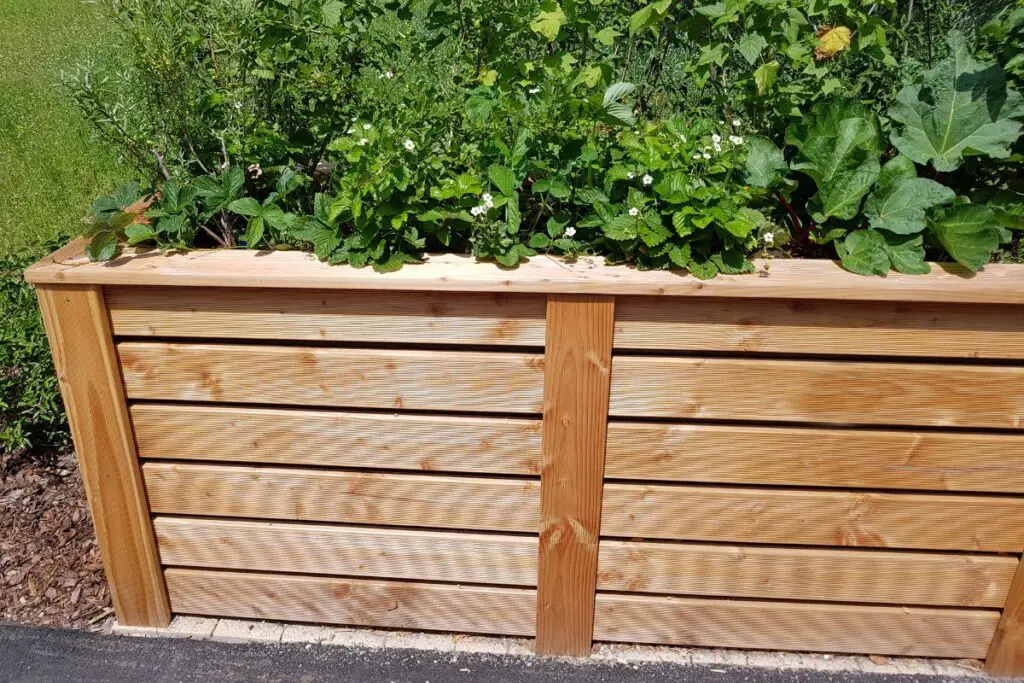
Measuring the beds and then calculating the cubic feet of soil, the cubic yard of soil, and the number of bags required for the bed: all these things are completely mathematical.
If math is not your thing, you can try the soil calculator to find all the measurements of the soil and the number of bags.
You only need to find out the length, width, and height of your bed.
Open any soil calculators from google and put the measurements of the bed.
The calculator will do the rest.
You don’t have to put extra effort into the calculations and stress out your mind.
A good calculator is the Omni Calculator.
Put the measurements in inches, feet, meters, centimeters, or whatever units are available.
However, it is better to use the foot unit.
You can also know the approximate cost if you put the price per unit.
If you have mistakenly bought more bags that got unused, don’t think they will get wasted.
The soil will sink, and you have to add a little more. So, here the extra soil will get used.
In some Home Depot stores, the staff usually sells 1-2 cubic feet of soil per bag.
Also read: 17 Materials To Put In Bottom Of Raised Bed?
Final thoughts
Understanding how much soil you need for your raised beds is quite a calculation.
You can buy some soil bags randomly and start filling your bed. Either there will be less soil or extra soil that gets wasted. So, measure, calculate, and then find out the amount.
Also read: 7 Best DIY Raised Bed Soil Mix: A Step-by-Step Guide
Multiply the length, width, and height of the bed. The result is the amount of soil you need for your bed. Since bulk soil is sold in yards, divide the multiplied result by 27. Transfer all the units into feet and then multiply.
If you don’t want to put effort into doing the math, use soil calculators. Put the length, width, and height measurements, and the calculator will do the rest. Using measurements is always better than random estimations.
Reference: ScienceDirect, American Society of Agronomy, Noble Research Institute, Soil for Raised Beds, Raised Bed Gardening.
